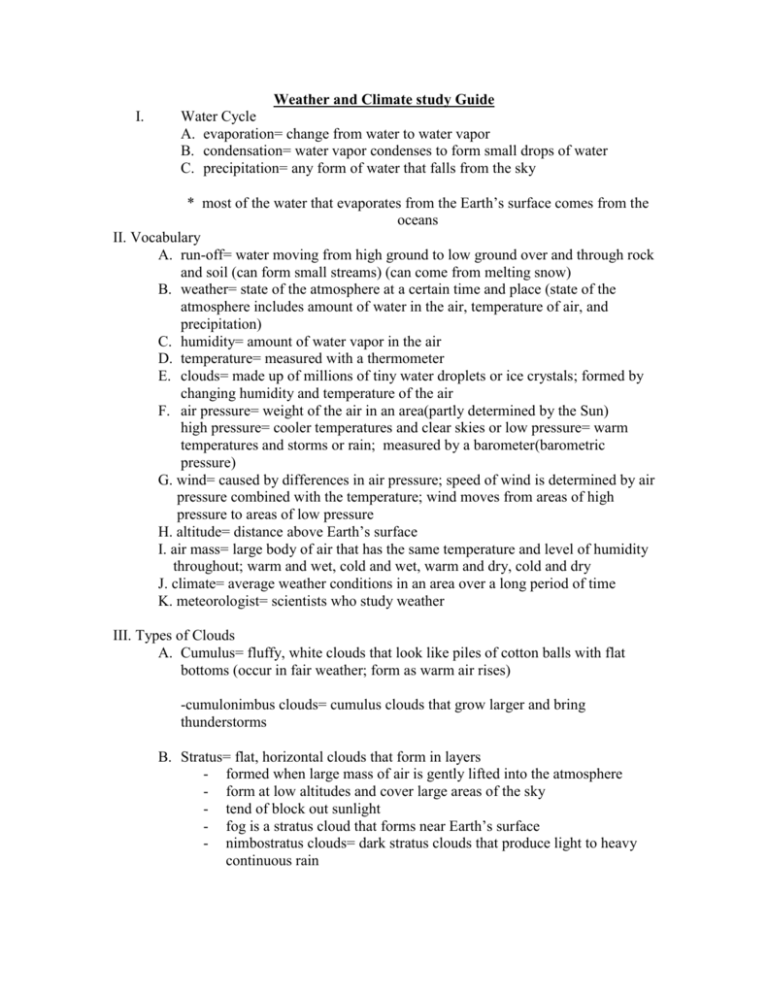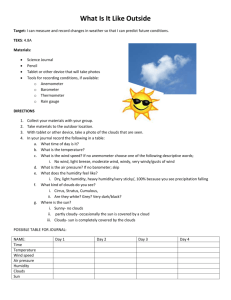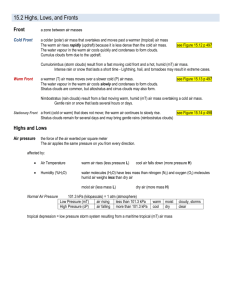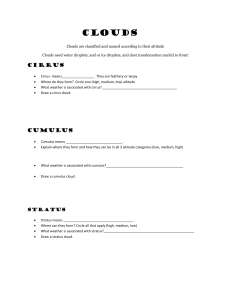Weather and Climate study Guide
advertisement

Weather and Climate study Guide I. Water Cycle A. evaporation= change from water to water vapor B. condensation= water vapor condenses to form small drops of water C. precipitation= any form of water that falls from the sky * most of the water that evaporates from the Earth’s surface comes from the oceans II. Vocabulary A. run-off= water moving from high ground to low ground over and through rock and soil (can form small streams) (can come from melting snow) B. weather= state of the atmosphere at a certain time and place (state of the atmosphere includes amount of water in the air, temperature of air, and precipitation) C. humidity= amount of water vapor in the air D. temperature= measured with a thermometer E. clouds= made up of millions of tiny water droplets or ice crystals; formed by changing humidity and temperature of the air F. air pressure= weight of the air in an area(partly determined by the Sun) high pressure= cooler temperatures and clear skies or low pressure= warm temperatures and storms or rain; measured by a barometer(barometric pressure) G. wind= caused by differences in air pressure; speed of wind is determined by air pressure combined with the temperature; wind moves from areas of high pressure to areas of low pressure H. altitude= distance above Earth’s surface I. air mass= large body of air that has the same temperature and level of humidity throughout; warm and wet, cold and wet, warm and dry, cold and dry J. climate= average weather conditions in an area over a long period of time K. meteorologist= scientists who study weather III. Types of Clouds A. Cumulus= fluffy, white clouds that look like piles of cotton balls with flat bottoms (occur in fair weather; form as warm air rises) -cumulonimbus clouds= cumulus clouds that grow larger and bring thunderstorms B. Stratus= flat, horizontal clouds that form in layers - formed when large mass of air is gently lifted into the atmosphere - form at low altitudes and cover large areas of the sky - tend of block out sunlight - fog is a stratus cloud that forms near Earth’s surface - nimbostratus clouds= dark stratus clouds that produce light to heavy continuous rain C. Cirrus= thin, wispy clouds that form high in the sky - form when the wind is strong - if they get bigger and thicker, these clouds indicate a change in the weather IV. Altitude and Cloud Formation A. cirrostratus= cloud that forms at high altitude(prefix is cirro-) B. Altostratus= clouds that form at middle altitude(prefix is alto-) C. Stratocumulus= clouds that form at low altitude(prefix is strato-) V. Fronts= area where two air masses meet A. cold front= forms when a cold air mass moves under a warm air mass; brings heavy rains, thunderstorms, sometimes snow B. warm front= forms when a warm air mass moves up and over a cold air mass -brings rainy, drizzly weather conditions, often followed by warm, clear weather D. occluded front= two cold air masses move toward each other, warmer air is between the cold masses and is pushed upward -brings cool temperatures and plenty of rain and snow E. stationary front= occurs when a warm air mass and cold air mass meet, but Neither front has enough energy to push against the other -brings days of overcast, rainy weather VI. Climate is affected by: A. temperature and rainfall B. location of a place on Earth C. wind patterns D. mountains-affect temperature and precipitation; influence rainfall E. oceans- water warms and cools more slowly than on land\ VII. Three Major Climate Zones A. Tropical Zone= near equator, where light and heat from the Sun are the most concentrated B. Temperate Zone= found between polar and tropical zones C. Polar Zone= Earth’s North and South Poles VIII. Breezes A. Valley breeze= warm air rises and flows up the mountain B. Mountain breeze= cool air sinks and flows down the mountain C. Sea breeze= cool, high pressure air over the ocean flows toward land(day) D. Land breeze= cool air over land forms area of high pressure and moves toward the ocean(night)







